The 1031 exchange rules in California are mostly the same as they are throughout the rest of the country.
That’s because it’s a federal IRS policy that the 1031 exchange is based on: IRS Code Section 1031.
There are, however, a few points specific to doing a 1031 exchange in California that are very important to know for real estate investors.
In this guide, we’ll explain how a 1031 exchange works and detail what those unique California 1031 exchange rules are, including:
- What is a 1031 exchange?
- What are the benefits of a 1031 exchange?
- 1031 Exchange rules in California
- CA Claw-Back Provision
- How to file a 1031 exchange on your California tax return
If you want to know ALL the 1031 rules in general (not specific to California), make sure to also read our ultimate guide to 1031 exchange rules.
First, let’s talk about why you might consider using a 1031 exchange to trade property you or your client’s own in California in the first place.
👉 Track depreciation and property expenses automatically with DoorLoop’s accounting software.
What is a 1031 exchange & its benefits?
A 1031 exchange is also referred to as a like-kind exchange.
That’s because it’s the exchanging of two properties which are “like-kind”, which essentially just means that they’re similar to each other in one or more ways.
Why would you use a 1031 exchange, then?
The benefit of using a 1031 exchange to sell and purchase investment property is to defer capital gains tax.
Think of it this way:
You’ll have to pay capital gains eventually, assuming you sell said property at some point down the line and within you or your client’s lifetime.
What if you could trade that property for another as many times as you’d like and still only have to pay capital gains on that one last final non-exchange sale?
What could you do with that flexibility?
The benefits for you and your clients are pretty diverse; much more than just deferring capital gains tax.
For example, you could:
- Shift properties from one market to another more promising market
- Trade high-maintenance properties to other lower-maintenance ones
- Or exchange high-risk properties for lower-risk ones or vice versa depending on market conditions
With that clear, let’s break down the 1031 exchange rules in California.
1031 Exchange rules in California
California 1031 exchange rules have some unique quirks.
For the most part, the only sticking point comes in when you’re doing an exchange out of state, whether that’s for:
- Property outside of CA for another within CA, or
- For property within CA for another outside CA
We’ll talk more about the CA claw-back provision later and why that is.
Before we do that, let’s go over what the 1031 exchange rules are for California.
To do a 1031 exchange in California:
- It must be a business or investment property
- Of equal or greater value
- And like-kind
- The buyer and seller of the two properties must be the same taxpayer
- And you must complete the exchange within the 1031 exchange timeline
Let’s break down each 1031 exchange rule a bit so they’re crystal clear:
1. Must be investment or business property

A 1031 exchange can only be done with business or investment property.
The State of California Franchise Tax Board doesn’t recognize recent 2017 federal tax code changes that made personal property completely ineligible for a 1031 exchange.
There are some cases where personal property can be 1031 exchanged.
However, it’s important to talk to your tax professional to make sure you’re taking the right steps to avoid any issues down the line if that’s the case.
If a mistake is made, the exchange could be considered invalid and you’ll be on the hook for capital gains taxes after the sale.
2. Both properties must be of equal or greater value

To qualify for 100% tax deferment, the net market value of the exchange property you’re purchasing can’t be of a lesser value compared to the relinquished property you’ve sold.
Let’s look at some examples.
This example qualifies for 100% deferment:
- Relinquished (sold) property: $1,250,000
- Exchange (purchased) property: $1,400,000
While this one doesn’t qualify because the exchange property is of a lower value:
- Relinquished (sold) property: $1,250,000
- Exchange (purchased) property: $1,200,000
One more important note: this doesn’t just apply to the net market value but to the mortgages as well.
Both the net market value and the mortgage on the replacement property must be of equal or greater value compared to the relinquished property.
So, for example, this exchange would qualify for 100% tax deferment based on the net market value:
- Relinquished (sold) property net market value: $1,250,000
- Exchange (purchased) property net market value: $1,400,000
But if this is the balance on the mortgages, it’s invalid because the mortgage on the new property is less than the balance on the mortgage of the relinquished property:
- Relinquished (sold) property mortgage: $650,000
- Exchange (purchased) property mortgage: $515,000
What if the value of the replacement property is less than the relinquished property?
If the value of the replacement property is less than the value of the relinquished property, you’ll pay the “boot” or the difference in value between the two properties.
In other words, immediately upon close, you’ll be responsible for paying capital gains tax on that difference.
In this example, you’d pay capital gains tax on the $50,000 difference:
- Relinquished property (the one you’re selling) value: $975,000
- Replacement property (the one you’re buying) value: $925,000
While the remaining $925,000 will be tax-deferred under the 1031 exchange policy.
3. Must be like-kind
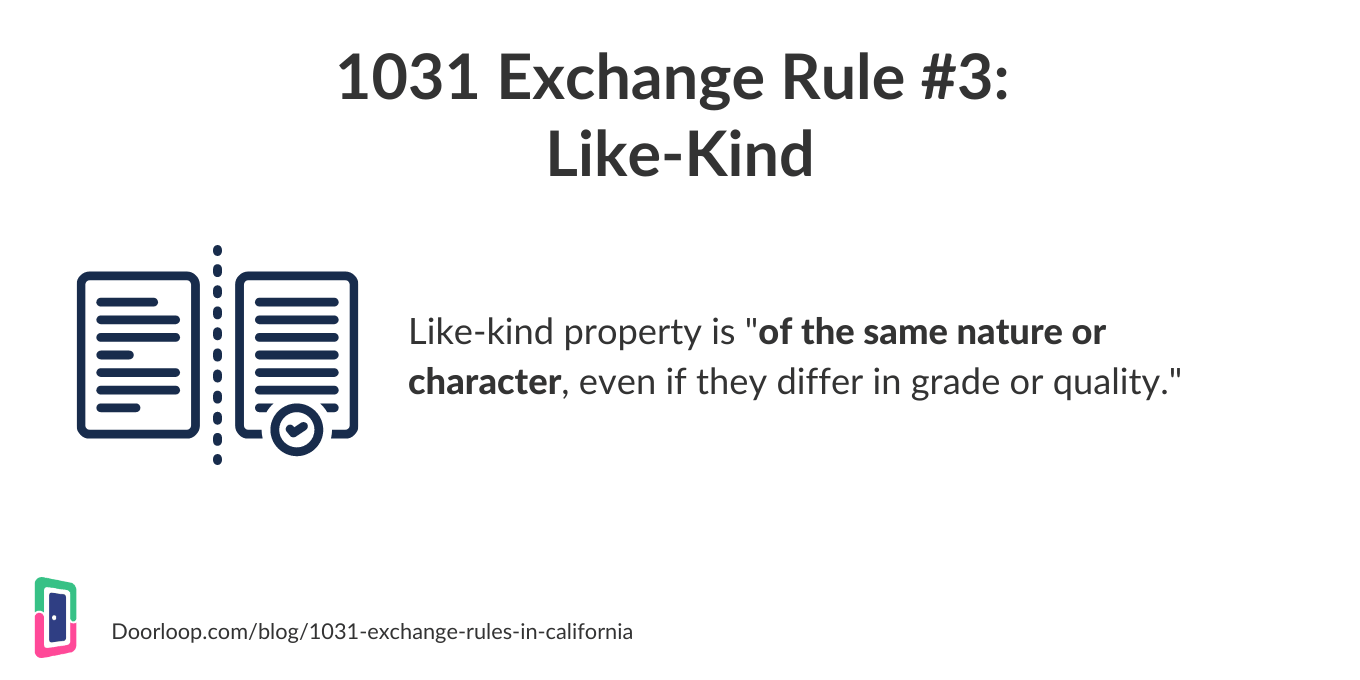
This one sounds confusing and potentially restricting, but it’s generally not.
According to the IRS, like-kind property is “of the same nature or character, even if they differ in grade or quality.”
That generally means both properties must be used for a similar purpose (and that includes a wide variety of purposes).
Even something as simple as both properties being commercial can fly, so it’s pretty flexible and generally nothing to worry about.
4. Must be the same taxpayer for both properties
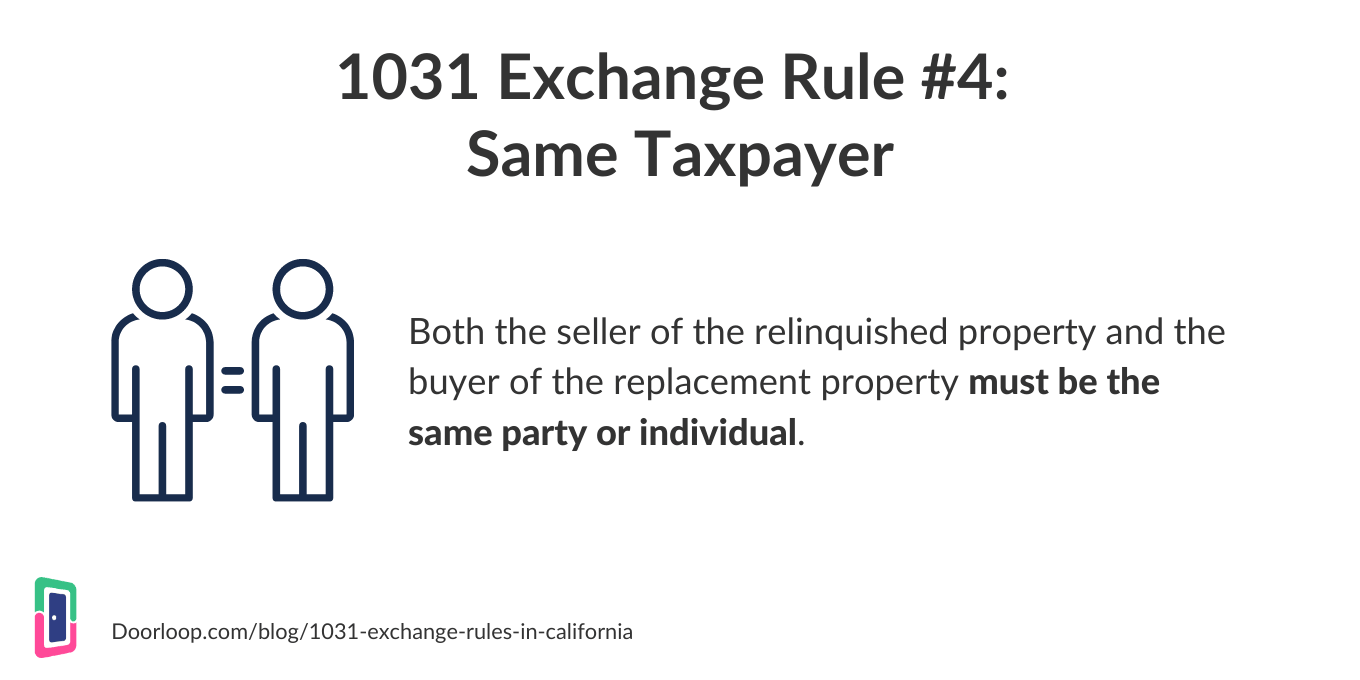
This is one of the more straightforward 1031 exchange rules.
This rule states that both the seller of the relinquished property and the buyer of the replacement property must be the same party or individual.
A 1031 exchange can’t be performed by multiple parties, in an effort to avoid a potential loophole to transfer properties between parties during an exchange.
5. Must complete the exchange within the 1031 exchange timeline

A 1031 exchange must be completed within a 180-day period. This starts from the date of the sale of the relinquished property.
If the exchange isn’t completed within that time frame, it’s considered invalid.
There are other important details to the 1031 exchange timeline, though.
First, you need to hire a qualified intermediary to manage the exchange. This should happen as soon as you set up a contract with your broker or realtor.
Next, you need to select 3 “exchange candidates” by the 45-day mark.
One of these 3 properties must be the property you finally select as the replacement property. You need to purchase it by the 180-day mark.
Once you’ve purchased the replacement property– your qualified intermediary releasing the original relinquished property sale funds for the purchase– the exchange is complete.
California Claw-Back Provision

No, the Claw-Back Provision isn’t about defending yourself against California mountain lions.
The California “Claw-Back” Provision is an important part of doing a 1031 exchange in California, though.
Not fully understanding the provision can lead to unnecessary double taxation down the road, so it’s a biggy.
The California Claw-Back Provision, per FTB Publication 1100 Irev 2007, section F, states: Capital gains accrued by California property are subject to California state tax.
In other words, California property sold in a 1031 exchange and replaced with an out of state property must pay capital gains on the final sale of that property.
Sounds pretty harmless, right?
After all, that’s how a 1031 exchange works.
The problem is that California applies this rule even after you’ve exchanged the California property for a property out of state.
California Claw-Back Provision example
Let’s look at an example to really illustrate where the issue arises.
Let’s say you exchanged a client’s property in California for another in Nevada.
The California property was worth $100,000 when you purchased it but has now appreciated to $250,000.
You defer taxation with the exchange and go on your merry way.
Years later, you sell that Nevada property.
The previous $250,000 value has now appreciated to $350,000.
You won’t just pay capital gains tax on the $100,000 capital gains on the Nevada property.
With the Claw-Back Provision, you’ll also pay CA tax on the $150,000 gains from the original California property you exchanged.
One way to get around this is to exchange for a property in CA before the ultimate sale, in which case you’ll only be subject to CA state taxes if the ultimate sale occurs in California.
Annual information return for former California property
California requires you to file an annual information return if you exchanged California property for non-California property every single year that you own the property.
According to a recent update by the California State Franchise Tax Board:
“Like-Kind Exchanges — For taxable years beginning on or after January 1, 2014, California Revenue & Taxation Code (R&TC) Sections 18032 and 24953 require California resident and non-resident taxpayers who defer gain on the sale or exchange of California property for out of state replacement property under Internal Revenue Code Section (IRC) 1031 to file an annual information return with the Franchise Tax Board (FTB). Taxpayers are required to file an information return for the taxable year of the exchange and in each subsequent taxable year in which the gain or loss attributable to the exchange has not been recognized. If a taxpayer fails to file the required information return, the FTB can estimate the net income, from any available information, including the amount of gain deferred, and propose to assess the amount of tax, interest, and penalties due.”
However, so long as you continue to exchange (or never sell) the property and submit the annual return, you won’t be charged taxes.

How to file a 1031 exchange on your California tax return
Filing a 1031 exchange on your California state tax return is pretty straightforward.
If you perform a like-kind exchange of California property, you must report that exchange on FTB Form 3840, provided you do both:
- Perform a 1031 exchange for property outside of California, and
- Defer gain or loss under IRC 1031
FTB 3840 must be filed in the year of the exchange.
It also has to be filed every year after that until one of the below:
- You pay California state taxes on the deferred gain or loss
- You exchange the new out-of-state replacement property with another out-of-state property in a 1031 exchange
- The owner of the replacement property dies
- Or the property is donated to a non-profit organization
Stay informed
IRS and California state-specific policies are changing all the time, often every few years.
Make sure to keep yourself informed, or at least brush up on the latest amendments. That way, you can not only reduce the chance of issues arising but make the most of the exchange.
If you want to learn more, check out our Master Guide: IRS 1031 Exchange Rules, Requirements, Timeline, and Guidelines.
Disclaimer
The materials and information available at this website and in this article are for informational purposes only and not for the purpose of providing tax or legal advice. You should contact your attorney and/or accountant to obtain advice with respect to any particular issue, question or problem.






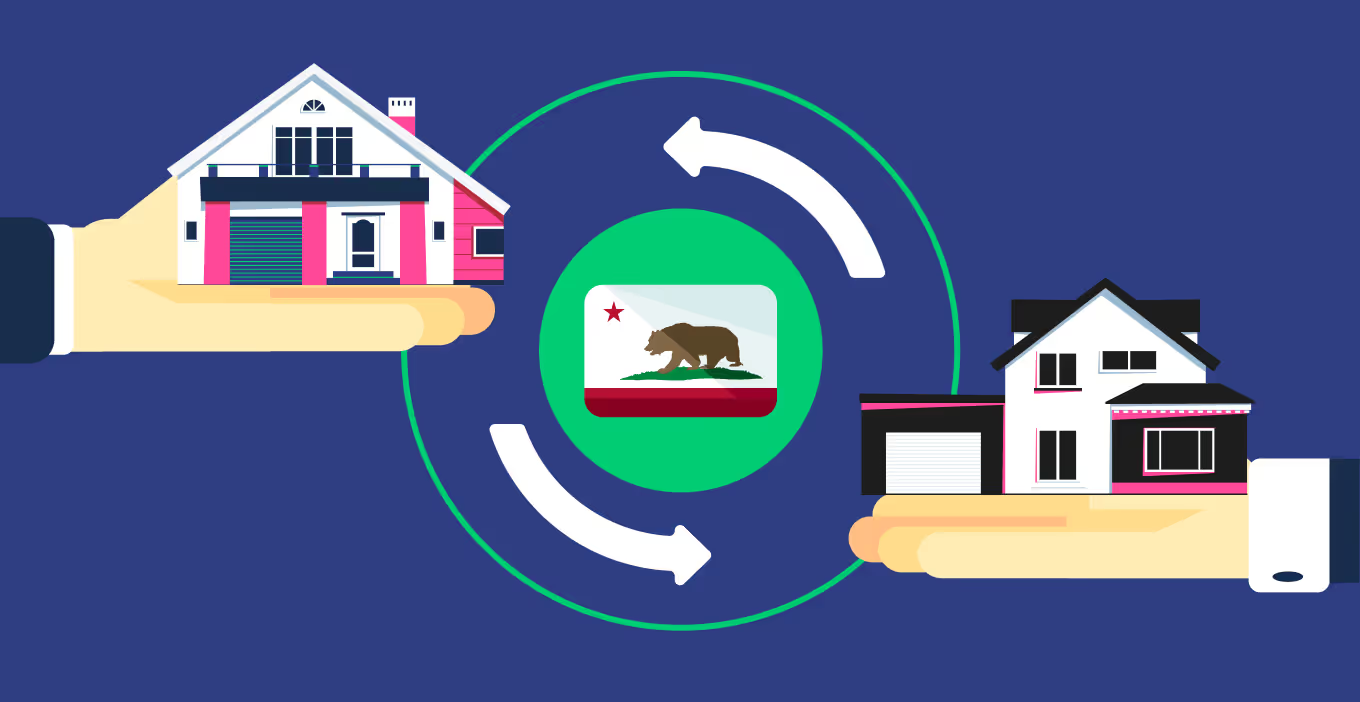






















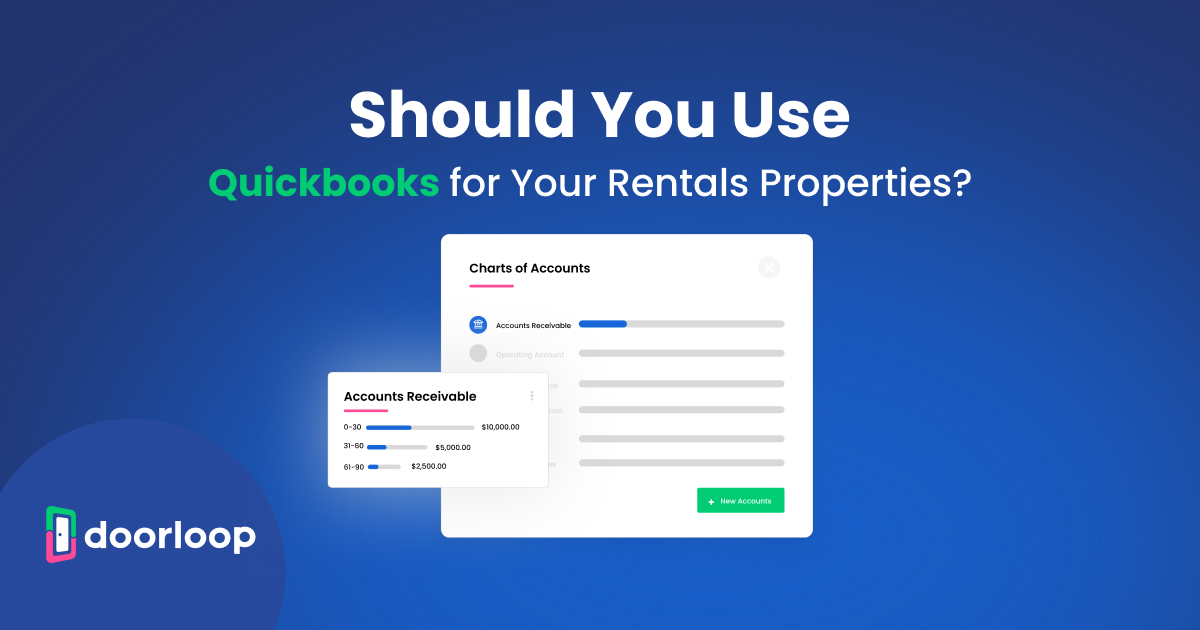

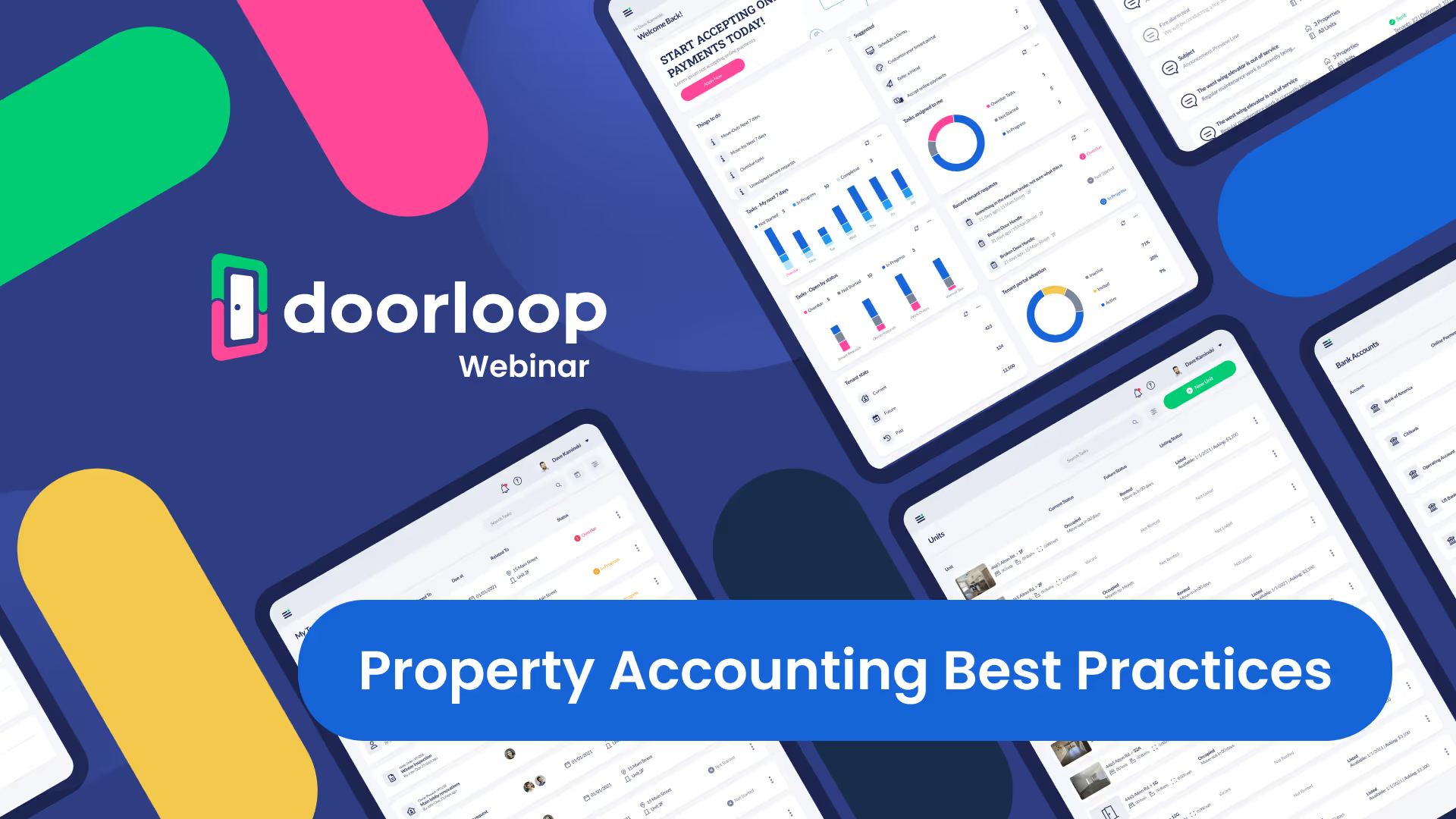
.svg)
.svg)

